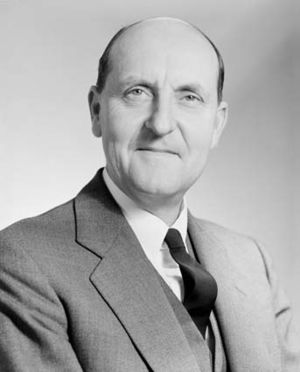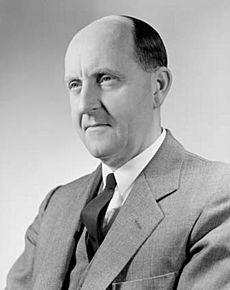Lenox Hewitt facts for kids
Quick facts for kids
Sir Lenox Hewitt
|
|
|---|---|
 |
|
| Secretary of the Prime Minister's Department | |
| In office 11 March 1968 – 12 March 1971 |
|
| Secretary of the Department of the Environment, Aborigines and the Arts | |
| In office 31 May 1971 – 19 December 1972 |
|
| Secretary of the Department of Environment and Conservation | |
| In office 20 December 1972 – 9 January 1973 |
|
| Secretary of the Department of Aboriginal Affairs | |
| In office 20 December 1972 – 9 January 1973 |
|
| Secretary of the Department of Minerals and Energy | |
| In office 20 December 1972 – 24 August 1975 |
|
| Personal details | |
| Born |
Cyrus Lenox Simson Hewitt
7 May 1917 St Kilda, Victoria, Australia |
| Died | 28 February 2020 (aged 102) Edgecliff, New South Wales, Australia |
| Spouse |
Hope Tillyard
(m. 1942–2011) |
| Relations | Robert John Tillyard (father-in-law) |
| Children | Patricia, Antonia, Hilary and Andrew |
| Occupation | Public servant |
Sir Cyrus Lenox Simson Hewitt (7 May 1917 – 28 February 2020) was an important Australian public servant. He worked for the Australian government for a long time, from 1939 to 1980. During this time, he was a senior adviser and led several government departments.
One of his most important jobs was being the head of the Prime Minister's Department. This was when John Gorton was the Prime Minister (1968–1971). He also played a big role as the head of the Department of Minerals and Energy when Gough Whitlam was Prime Minister (1972–1975). Later, he became the chairman of Qantas, a major Australian airline, from 1975 to 1980.
Contents
Early Life and Education
Lenox Hewitt was born in St Kilda, Victoria, Australia, on 7 May 1917. He went to Scotch College, Melbourne for his schooling. He then studied at the University of Melbourne. He earned a Bachelor of Economics degree while also working part-time for a company called BHP.
Starting His Career
From 1939 to 1946, Lenox Hewitt worked as an Assistant Secretary. He helped Sir Douglas Copland, who was an economic adviser to the Prime Minister.
After that, he joined the Department of Postwar Reconstruction from 1946 to 1949. This department helped Australia rebuild after World War II. In 1950, he moved to London. There, he worked at the Australian High Commission until 1953.
When he returned to Australia, he joined the Department of the Treasury. This department manages the government's money. He held senior roles there from 1955 to 1966. In 1967, he became the head of the Australian Universities Commission. This group helped guide universities.
Working with Prime Ministers
Gorton Government (1968–1971)
In January 1968, John Gorton became the Prime Minister. This happened after the previous Prime Minister, Harold Holt, sadly passed away. Prime Minister Gorton wanted new advice. So, in March, he appointed Lenox Hewitt to lead the Prime Minister's Department. This department works closely with the Prime Minister.
Lenox Hewitt was known for being very smart and good at details. He could make quick decisions and didn't like unnecessary rules. In 1971, he was given the title of "Sir" (knighted) for his important work. Prime Minister Gorton resigned in March 1971 after a vote showed he didn't have enough support from his party.
McMahon Government (1971–1972)
After Gorton, William McMahon became Prime Minister. He changed the government departments around. Lenox Hewitt was then appointed to lead a new department. This was the Department of the Environment, Aborigines and the Arts. It was responsible for protecting nature, helping Aboriginal people, and supporting the arts.
Whitlam Government (1972–1975)
In December 1972, Gough Whitlam's Labor Party won the election. The new Minister for Minerals and Energy, Rex Connor, chose Sir Lenox Hewitt to be the first head of the Department of Minerals and Energy. This department was in charge of Australia's natural resources like coal and oil.
Sir Lenox Hewitt was involved in important discussions about Australia's resources during this time. He was a key figure in the government's plans for energy and mining.
Later Life and Roles
In 1975, Prime Minister Whitlam appointed Sir Lenox Hewitt as the Chairman of Qantas. Qantas is Australia's national airline. He led Qantas for five years until 1980.
After his time at Qantas, he continued to serve in other important roles. He chaired the Snowy Mountains Council. He was also a member of the Australian Atomic Energy Commission. In 1985, he became the Chairman of the New South Wales State Rail Authority, which manages trains in that state.
Sir Lenox Hewitt lived to be over 100 years old. He celebrated his 100th birthday in May 2017. He was still active and shared his experiences in interviews. He passed away on 28 February 2020.
Honours and Awards
Sir Lenox Hewitt received several honours for his service:
- In 1963, he was made an Officer of the Order of the British Empire (OBE). This was for his work at the Treasury.
- In 1971, he was knighted, earning the title "Sir." This was for his leadership of the Prime Minister's Department.
- He won the Tony Jannus Award in 1989 for his contributions to aviation.
- In 2001, he received the Centenary Medal. This award recognized his long and important service to Australia.
Family Life
In 1942, Lenox Hewitt married Hope Tillyard. She was also a very accomplished person. Hope Hewitt became a respected English lecturer at the Australian National University. She was also a poet and writer.
They had four children: Patricia, Antonia, Hilary, and Andrew. Their daughter, Patricia Hewitt, later moved to the United Kingdom. There, she became a politician and a government minister.
Images for kids



